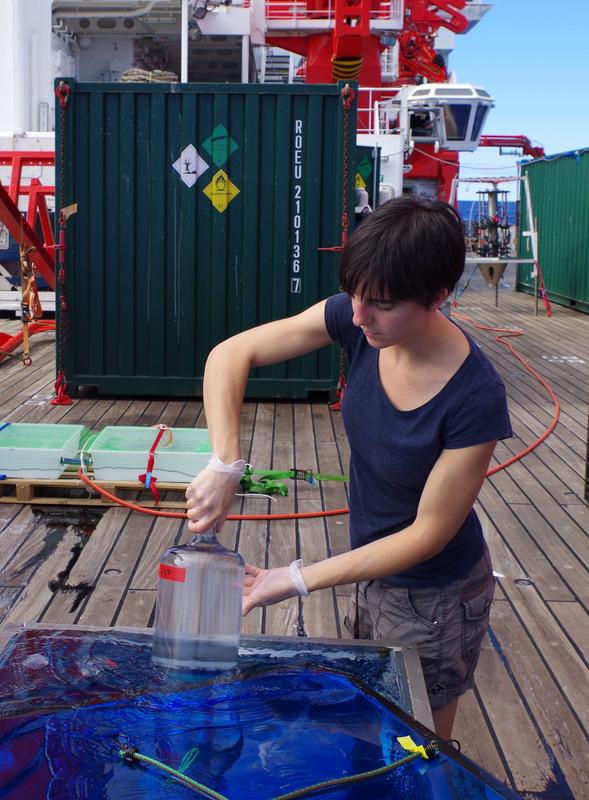Small bug, large impact: A new key player in the marine nitrogen cycle

Clara Martínez-Pérez on board the research vessel, sampling an incubation bottle from a surface water flow-through incubator. Tim Ferdelman
Nitrogen is essential to all forms of life: It is part of proteins, nucleic acids and other cellular structures. However, many oceanic regions are limited by the availability of nitrogen, such as the tropical North Atlantic. In this region, nitrogen supply to the open ocean comes mainly from nitrogen fixation and to a lesser extent from atmospheric deposition.
Nitrogen fixation is the transformation of the inert nitrogen gas from the atmosphere into other forms of nitrogen, which can then be taken up by other microorganisms such as primary producers. The organisms performing nitrogen fixation are called nitrogen fixers or diazotrophs.
They can be considered the fertilizers of the large areas of the nutrient-limited oceans. Thus, it is crucial to determine the factors and key players of nitrogen fixation in order to understand how global changes might impact nitrogen fixation in the future and the possible resulting impacts on the ocean’s productivity.
Clara Martínez-Pérez and co-authors from the Max Planck Institute for Marine Microbiology in Bremen (MPI Bremen), the University of Kiel, and the GEOMAR in Kiel have now assessed the contribution of one of the most abundant diazotrophs (UCYN-A) in the ocean to total nitrogen fixation in the tropical North Atlantic. Despite its relatively high abundance compared to other diazotrophs, the activity and contribution of this small diazotroph, living in symbiosis with a small unicellular alga, has never been determined before. Their surprising results show that previous knowledge about the key players in nitrogen fixation might have to be revised.
A new player in the nitrogen cycle
The tropical North Atlantic, harboring about one quarter of global nitrogen fixation, has previously been believed to be dominated by Trichodesmium, a filamentous cyanobacterium blooming in such large numbers that it can be seen with the naked eye and by satellites. “However, there are many other diazotrophs in the ocean whose importance had not yet been quantified”, Martínez-Pérez explains.
To quantify the importance of UCYN-A, the scientists used several methods including a NanoSIMS, which allows for the detection and quantification of the activity of individual cells. “By this, we can quantify the ecological role of UCYN-A in the marine nitrogen cycle, which is essential information for global models of nutrient cycling”, says co-author Wiebke Mohr from the MPI Bremen.
Their results were up for a surprise: Martínez-Pérez and her colleagues show that UCYN-A is as important for nitrogen fixation in the tropical North Atlantic as is Trichodesmium. “Although Trichodesmium cells were very numerous, they were not fixing much nitrogen gas”, says Martínez-Pérez. In contrast, the much smaller UCYN-A was very active. Living in association with a small alga also means that UCYN-A not only fixes nitrogen for itself but also the host alga. As a result, it contributed as much as Trichodesmium to the total nitrogen fixation across the tropical North Atlantic.
Oceanic cosmopolitans
The scientists further explored the global distribution of UCYN-A. They are found all over the oceans from the Arctic to the Antarctic circles (which is not the case for Trichodesmium which is usually in waters above 20 °C). “Thus, UCYN-A has the potential to be one of the main contributors to nitrogen fixation not just in the tropics but around the globe”, says Martínez-Pérez. It is interesting to note that, despite their activity and ecological relevance, the abundance of these symbioses is very low compared to other microorganisms in the oceans.
“One of the major challenges when quantifying these organisms was to actually find them under the microscope, since they are so rare”, explains Mohr. The low abundance of these organisms implies that they are rapidly consumed by grazers or otherwise removed from the surface waters. This would result in a very efficient transfer of the fixed nitrogen to the oceanic food web, and suggests that the contribution of UCYN-A to nitrogen fixation is even higher than quantified here. “Next, we would like to look into other regions of the ocean and quantify the abundance and activity of UCYN-A there. This will allow for deeper insights into their global role”, concludes Martínez-Pérez.
Original publication
The small unicellular diazotrophic symbiont, UCYN-A, is a key player in the marine nitrogen cycle. Clara Martínez-Pérez, Wiebke Mohr, Carolin R. Löscher, Julien Dekaezemacker, Sten Littmann, Pelin Yilmaz, Nadine Lehnen, Bernhard M. Fuchs, Gaute Lavik, Ruth A.
Schmitz, Julie LaRoche, Marcel M. M. Kuypers. Nature Microbiology
DOI: 10.1038/nmicrobiol.2016.163
Contact
Dr. Wiebke Mohr,
Phone: 0421 2028 – 630
E-Mail: wmohr@mpi-bremen.de
Clara Martínez-Pérez
Phone: 0421 2028 – 653
E-Mail: cmartine@mpi-bremen.de
Or the press office
Dr. Fanni Aspetsberger
Phone: 0421 2028 947
E-Mail: faspetsb@mpi-bremen.de
Media Contact
All latest news from the category: Life Sciences and Chemistry
Articles and reports from the Life Sciences and chemistry area deal with applied and basic research into modern biology, chemistry and human medicine.
Valuable information can be found on a range of life sciences fields including bacteriology, biochemistry, bionics, bioinformatics, biophysics, biotechnology, genetics, geobotany, human biology, marine biology, microbiology, molecular biology, cellular biology, zoology, bioinorganic chemistry, microchemistry and environmental chemistry.
Newest articles

First-of-its-kind study uses remote sensing to monitor plastic debris in rivers and lakes
Remote sensing creates a cost-effective solution to monitoring plastic pollution. A first-of-its-kind study from researchers at the University of Minnesota Twin Cities shows how remote sensing can help monitor and…

Laser-based artificial neuron mimics nerve cell functions at lightning speed
With a processing speed a billion times faster than nature, chip-based laser neuron could help advance AI tasks such as pattern recognition and sequence prediction. Researchers have developed a laser-based…

Optimising the processing of plastic waste
Just one look in the yellow bin reveals a colourful jumble of different types of plastic. However, the purer and more uniform plastic waste is, the easier it is to…



